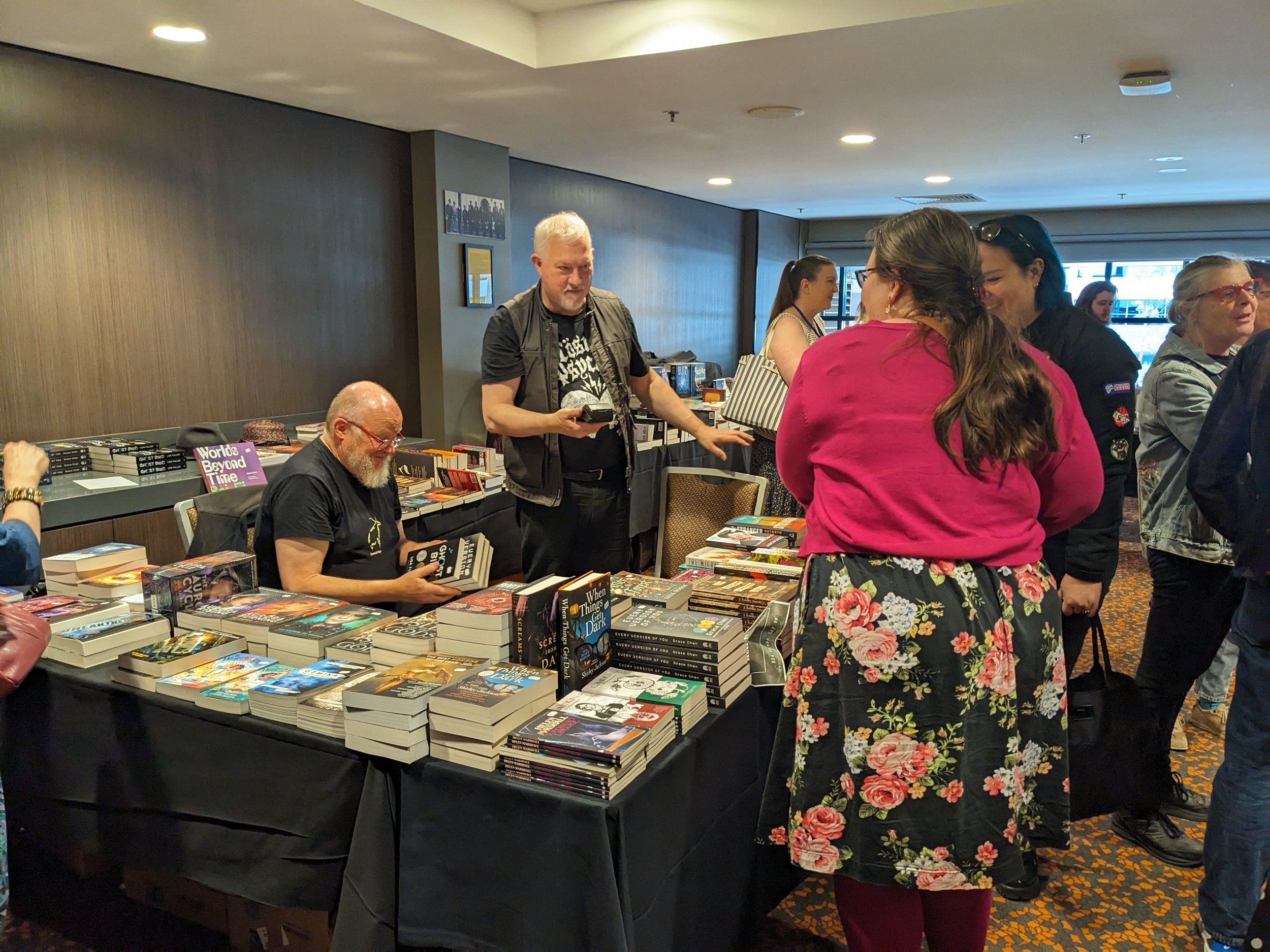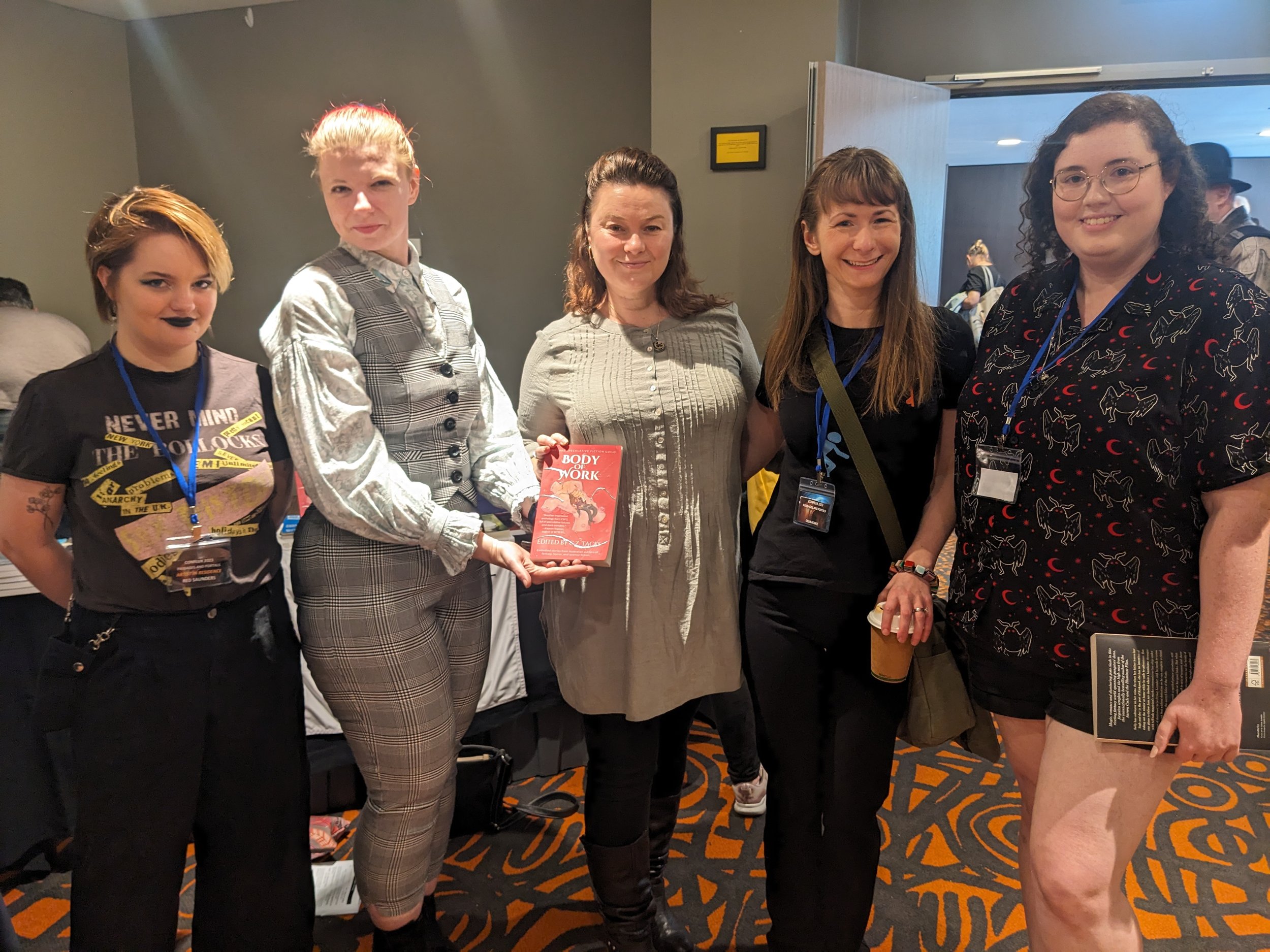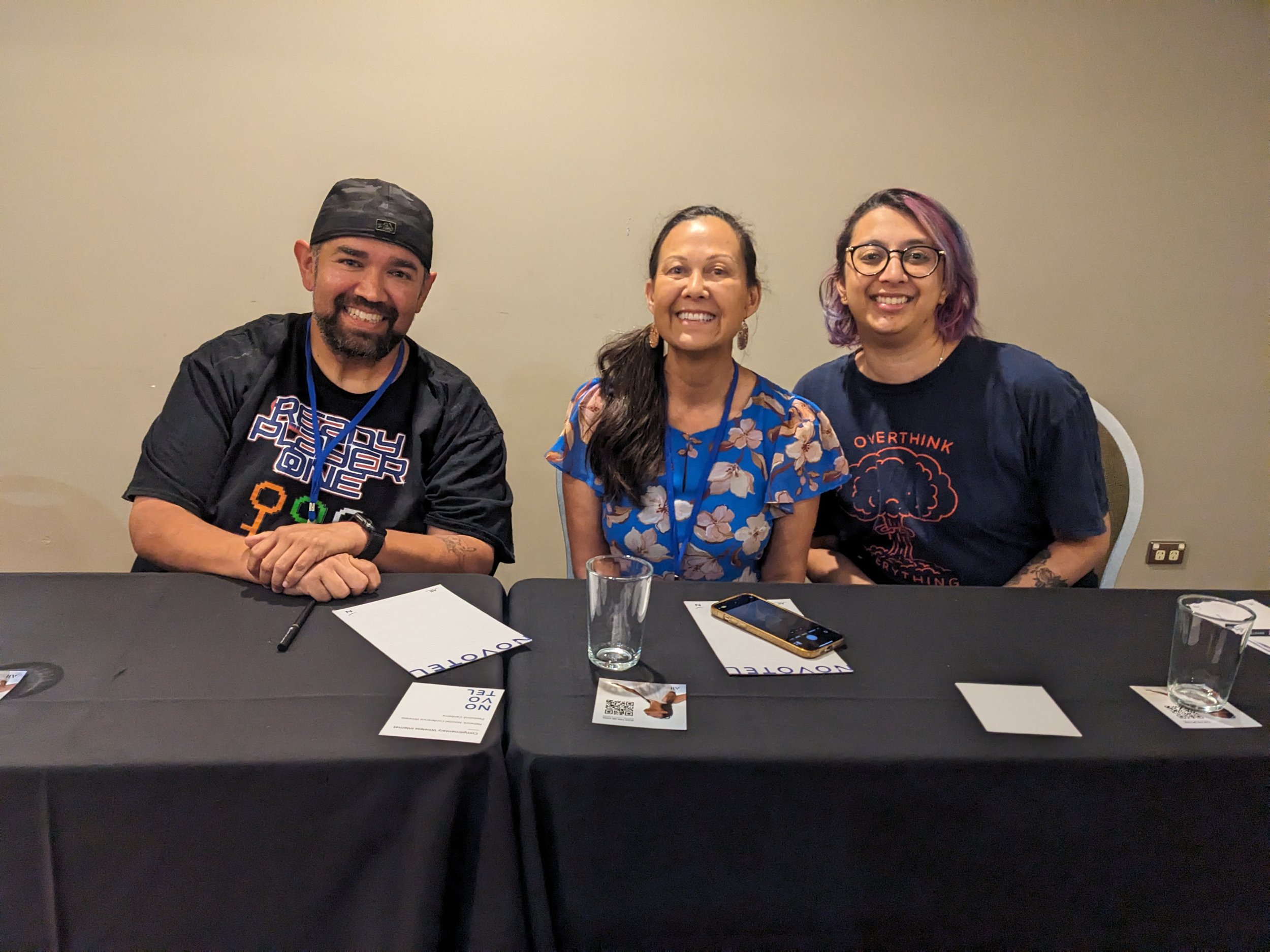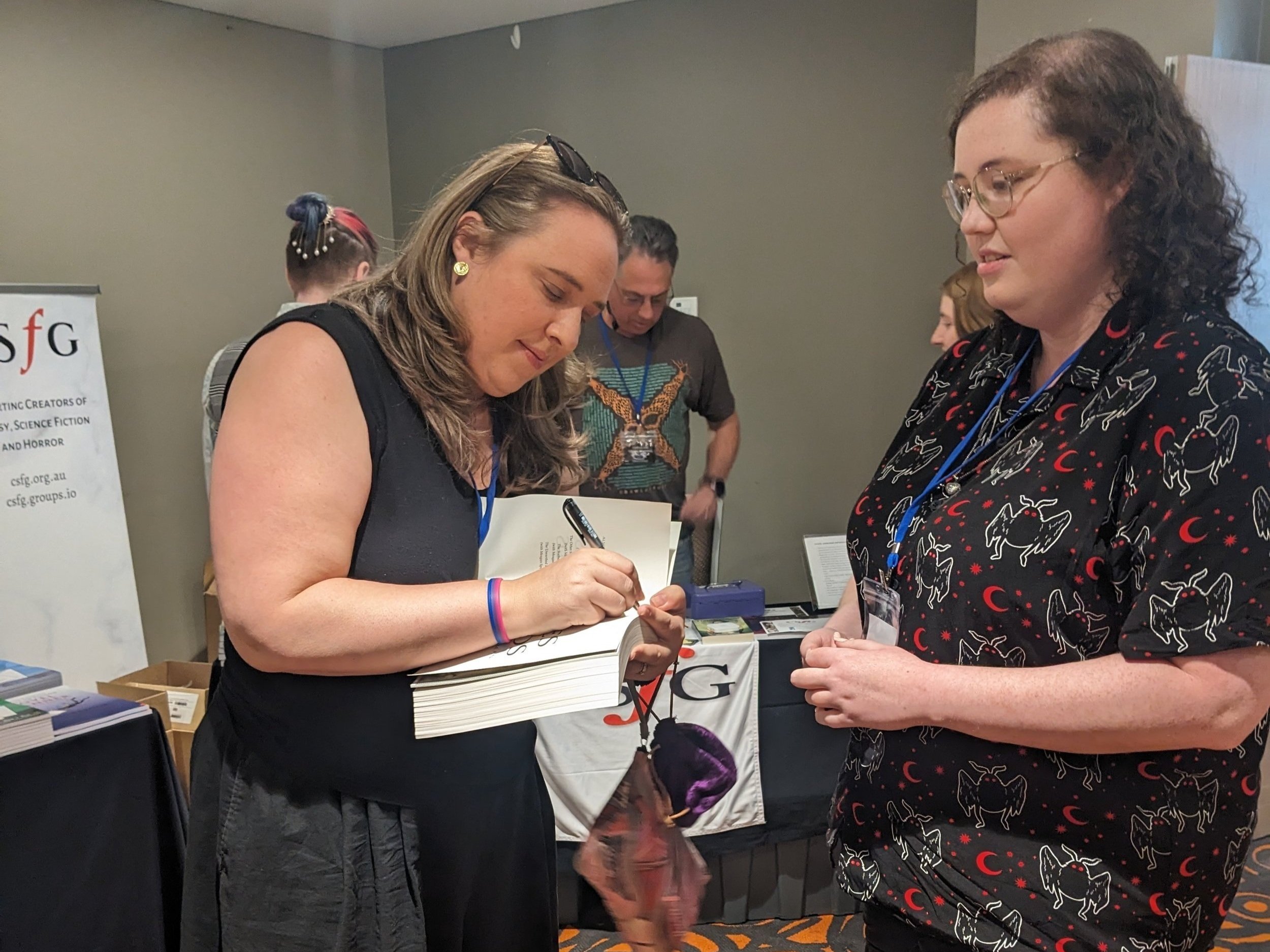Conflux 17: Passages and Portals
By Peter Searles
Walking in from Northbourne Avenue to the lobby of Novotel Canberra, I looked uncertainly left and right. I saw check in desks, elevators, and a large staircase heading upwards. I decided on the elevator. But when the doors slid shut and my hand was still hovering over the button pad, my lift companion came to the rescue.
‘Here for the conference? It’s the first floor. Follow the geeks!’
‘That should be easy’, I said. ‘I am one!’
The elevator doors opened onto a busy lounge. Large groups were huddled together, chatting and gesturing enthusiastically. The room and the adjoining bar were buzzing with conversation about this or that fictional universe, the laws of magic that govern them, and the characters they’re best known for. I had been transported. For this weekend, the first floor of the Novotel was focal point to all things speculative fiction (spec-fic).
Conflux is Canberra’s annual speculative fiction conference. For those who may be strangers to this world, spec-fic refers to sci-fi, horror, fantasy, or any fiction that deals with settings, themes or characters outside our usual experience of reality. The conference draws an impressive crowd of passionate and knowledgeable devotees. After seeing how much fun everyone was having, how familiar the attendees had become over the course of the weekend, I was disappointed that I was only managing to catch the final day of the event. And while I wasn’t joking when I said I’m a geek, my spec-fic fandom doesn’t extend far beyond my love of horror movies. I was expecting not only a fun day, but an instructive one too.
The theme of the 17th annual Conflux conference was ‘passages and portals’. For the first session of the day, I took my seat in front of the panel that promised to explain what this meant. The panellists were Lyss Wickramasinghe, Jason Franks and UC student and Conflux intern, Rebecca Hayward. But by the end of the session, I felt I’d come to know the entire audience as well. We were all friends here, participating in an open discussion that allowed all voices in the room to be heard and engaged with.
Portal fantasy is exactly what it sounds like: works of fiction in which characters are transported through space and/or time and must learn to inhabit the unfamiliar world they find themselves in. The panellists and audience members took turns sharing their favourite examples, and through comparison, the commonalities and variations in the genre became apparent. For example, a portal might come in the form of a doorway that is stepped through, a pathway that’s followed or an event such as an accident or a death. The new world the character inhabits may be full of danger and menace, or it could be a place in which they find a sense of belonging they’ve long been searching for, and they may not wish to return.
For a while, the discussion focussed on a sub-genre of anime known as ‘Truck-Kun’, wherein the protagonist is transported through the act of being run over by a truck. While examples of this trope can be seen as far back as the 1980s, it is only in the past decade that the frequency of its use has grown into a kind of joke among fans, which has opened the doors to ever more self-referential iterations. These include Isekai Transporter, a manga originally published on Facebook which focuses on Ni, an employee of the company of truck drivers which contracts their services to track down and slam their trucks into heroes, thereby sending them to fantasy worlds to begin their stories.
With my notebook full of exciting new portal fantasy recommendations, I followed my frequent writing class companion Rebecca Hayward into the rooms that formed Conflux’s central hub. I was told there were many people I had to meet. Rebecca had been working with the Canberra Speculative Fiction Guild (CSFG) as part of a Work Integrated Learning (WIL) unit for her creative writing course at UC. Besides assisting in preparations for Conflux, Rebecca had worked with a team of CSFG editors to compile a book titled Body of Work, which is the latest in the CSFG’s annual series of spec-fic anthologies. I met the book’s lead editor C.Z. Tacks, contributing authors C.H. Pearce and Freya Marske, and Red Saunders, the artist behind the book’s gorgeous cover image. I also had the pleasure to meet one of the conference’s guests of honour, the acclaimed and widely published sci-fi and fantasy author Amie Kaufman. Amie told me about her long association with Conflux, and how warmly she was welcomed into the spec-fic community when she began attending the conference many years ago. As I chatted to one wonderfully talented artist after another, I saw exactly what she meant. The conference was an annual reunion of dear old friends, and this community is eager to welcome new members into the fold.
The next panel discussion I joined was ‘Stranger Lands’. It investigated methods and considerations around the use of portal fiction in the telling of migrant stories. Chairs Lyss Wickramasinghe, Americo Alvarenga and Lee Murray shared their perspectives as authors and fans of portal fantasy through the lens of their Indian, Nicaraguan and Vietnamese heritage respectively.
In many ways, portal fantasy is the ideal genre for the telling of migrant stories. When we follow a protagonist whose previous experiences have left them underprepared for life in an unfamiliar place, the feelings of being disconnected both from one’s traditional and adopted cultures are elegantly captured. It’s been positive to see the growing cultural appetite for these stories in recent years, and there are many wonderful examples of writers using speculative fiction to explore migrant themes (the success of the film Everything, Everywhere, All at Once was offered as a prime example).
But there are inevitable challenges. The panel spoke of some common aspects in the experience of migrants. In many cases, as Lyss Wickramasinghe observed, the problematic aspects of traditional cultures are challenged by younger generations that have taken on the values of the western countries their families have migrated to. While painful, it’s also the kind of conflict that good stories are made from. Americo Alvarenga added that family members may not want the stories of their people to be told, potentially perceiving it as gossip or an invasion of privacy. The panellists agreed that such objections should be acknowledged, but they don’t outweigh the importance of ensuring these stories aren’t lost. Respect, consultation, and sensitivity become vitally important for writers in this space.
Of course, an increasingly blended global culture enriches our shared experience in so many ways. For spec-fic, one of the benefits are new additions to the pool of monsters and creatures a writer can draw upon. The panel observed that the sharing of cultural myths has meant that monsters from all parts of the world are being introduced to audiences that were previously unaware of them.
I made use of another short break to stock up on more books. This included an excellent collection of short stories by Helen Marshall called Gifts for the One Who Comes After and an anthology: Body Shocks – Extreme Tales of Body Horror. Forgetting for a moment the alternate reality I was in, I was surprised to be tapped on the shoulder by the anthology’s editor, Ellen Datlow, while in the middle of purchasing the book! Within minutes, several of the authors whose stories I’d just bought were lining up to sign my copy.
The final session of the day featured two very popular sessions. One was a panel on editing professionally, a topic that is clearly relevant to the careers of many Conflux attendees. There was also a session called ‘Five Minute Fiction’, in which attendees were invited to read a five minute except of their spec fic stories, novels, screenplays, or whatever else they have been working on. But while all that was going on, I slipped into a mostly empty room for one of the more niche discussions of the day.
C.Z. Tacks had gathered friends and fellow writers Emilie Morscheck, C.H. Pearce, Americo Alvarenga, and Rik Lagarto for a panel that looked at the portal theme from a different angle. Portal is a 2007 platform computer game published by Valve. As C.Z. Tacks explained, the game was distributed as a kind of apology to fans of Valve’s Half Life, for the long wait they were enduring while Half Life 2 was being developed. But Portal, while tiny (you can pretty much knock it over in one sitting), became hugely popular due to its ingenious simplicity and hilarious, dark humour.
The panellists broke down the game through the lens of minimalist fiction analysis, for their own enjoyment and for the benefit of those in the room (like me) who had never played it. I have since played the game and can confirm, minimal is the perfect way to describe it. The game is built on the most stripped back of elements: there’s a character (the unnamed and silent individual the player inhabits), a setting (the Aperture Science Laboratories research facility), a portal gun, and an evil robot named GLaDOS (Genetic Lifeform and Disk Operating System).
The gun is capable of shooting blue and orange portals onto the walls of the facility. Only one of each portal can be placed at a time, and when the character enters the portal of one colour, they are instantly spat out of the other. With this device in hand, the player must navigate a series of testing scenarios, solving puzzles in order to progress to the next test. All the while, GLaDOS observes and speaks to the character, presenting herself as a friendly assistant, while clearly working to deceive and manipulate the player for reasons they must piece together through subtle clues while playing the game.
As a player of Portal, there is a strong sense of being trusted by the game’s creators. Story is never fed to you. Instead, it is gradually revealed through the game play. The panellists discussed how as writers, we might take the game as an example for our own writing projects. Players/viewers/readers don’t want to be spoon-fed. Their enjoyment is directly related to the effort they put in to piecing a story together. C.Z. Tacks shared with the room one approach (a suggestion from another writer she had come across) for achieving a satisfyingly scant level of detail in the writing of fiction. First you write down everything the audience needs to know. Then you write the story, assuming that the reader is already aware of the information you’ve just listed. Then throw away the first document. While this seems somewhat radical, I plan to give it a go for my next short story.
Having played Portal and spoken about it with several other people since the conference, I’ve decided I must be one of the last people on Earth to hear about it. Nevertheless, I’m going to recommend to anyone reading this who has not yet had the pleasure - go out and find yourself a copy!
Rounding off the final day of Conflux, attendees crowded into a double meeting room for the closing ceremony of this year’s conference. Thanks were given, and the outgoing organising team announced those who will take their place next year. The winners of various prizes were also announced, and the complete list of winners can be found here. https://conflux.org.au/blog/
While everyone filed through the halls to kick on with drinks in the hotel bar, I slipped back out onto Northbourne Avenue and found the world of normality was still chugging along. The portal to the wonderful world of Conflux was closing. As well as several new friends, I came away with a backpack full of books, and a long list of recommendations for further reading and viewing. There’s an infinite number of realities out there for my imagination to get lost in. I’ll take that as a comfort while I count down the long months until my return to Conflux 18.





